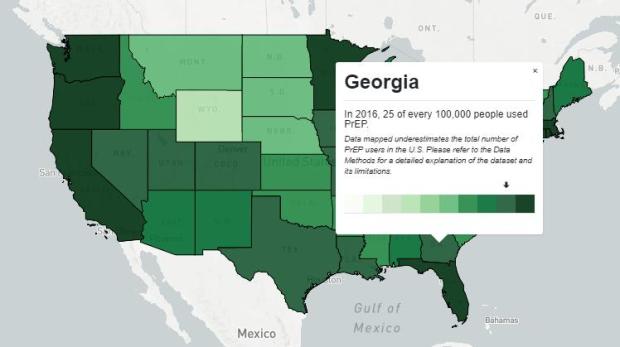Georgia has the highest rate of new HIV diagnoses in the nation, but the use of a prophylactic drug in the state lags behind the U.S. average.
The new data on the drug regimen known as PrEP, or pre-exposure prophylaxis, come from AIDSVu, an interactive mapping tool produced in a partnership by Emory University’s Rollins School of Public Health, Gilead Sciences, state health departments and the CDC.

The South in general is the overall center of the national HIV epidemic. Half of the new HIV diagnoses occur in the South, as well as half of the AIDS-related deaths.
“The South is so heavily impacted,’’ said Patrick Sullivan, an Emory University expert on HIV/AIDS and director of AIDSVu, which also breaks down the diagnosis data by county and city.
Gilead makes Truvada, a PrEP medication that can help shield healthy, HIV-negative people from infection if they are exposed to the virus through sexual activity or drug use.
The PrEP figures are from 2012-2016. “Over that time, there has been an 880 percent increase in PrEP,’’ said Sullivan. “That’s a really impressive improvement.”
But just 30 percent of users of PrEP live in the South, Sullivan said. Use of the drug in the South “is falling short,’’ he added.
The national PrEP use average is 28 people per 100,000. In Georgia, it’s 25.

“There are opportunities to increase education and access to PrEP,’’ Sullivan said.
In some states where there is more public health outreach — including provisions to help pay for medications or doctor visits — use of the drug regimen is higher, Sullivan said, citing New York and Washington state as examples.

Many men having sex with men think they’re not PrEP candidates, he said. Actually, such men are one of the main populations at risk.
AIDSVu, in its eighth year, not only shows data but helps enable users to find a PrEP provider.
The Georgia new HIV diagnosis rate that Sullivan cited comes from 2016 data, the most recent available.
There are many factors that lead the South to have a high HIV burden. They include the region’s high rates of poverty and low rates of health insurance; problems in access to health care; the stigma attached to the disease; income inequality; and the persistently high rate of sexually transmitted infections.
There’s a strong racial component as well. In Georgia, the HIV prevalence rate among black males is 5.8 times that of white males, and the HIV prevalence rate among Hispanic/Latinos is 1.9 times that of white males.
Dr. Gregory Felzien of the Georgia Department of Public Health said Wednesday that the agency continues “to work tirelessly with community and collaborative partners at the local, state and national level in meeting the challenges in preventing new HIV infections.”
He cited a multipronged approach that features education, use of alternative service methods in reaching more Georgians, and expansion of a comprehensive HIV prevention plan, which includes greater access to PrEP.
“These efforts have been successful with the establishment of PrEP clinics here in Georgia,’’ Felzien said.

